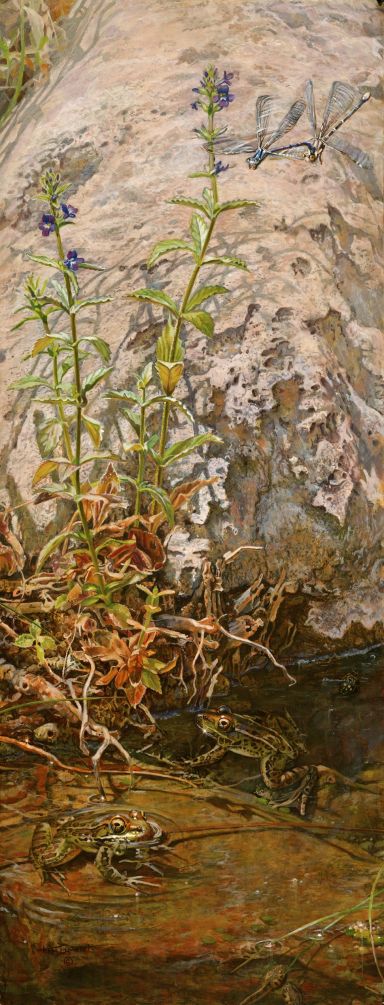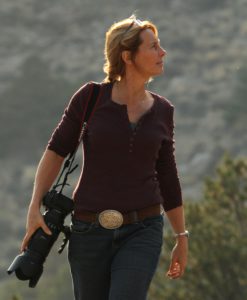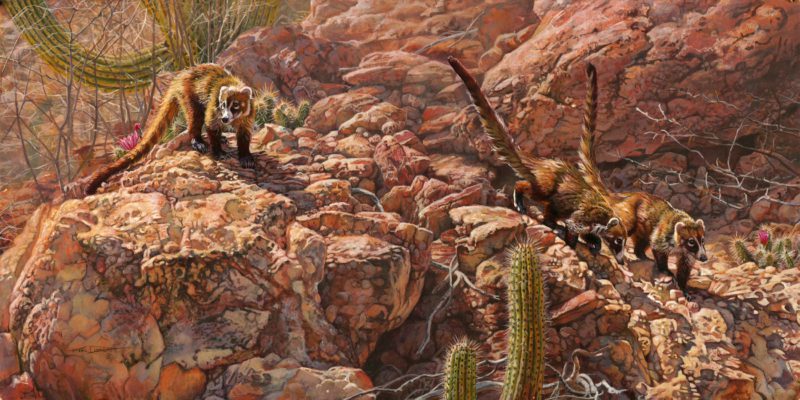I was so excited when we spotted Coatis on our first Nacapulae Canyon walk. I had only seen them in zoos up to that date. They were descending from a small grove of Palms when we caught our first glimpse. Seeing them in their native environment of red rock, Organ pipe, Barrel, and Hedgehog Cactus along with the Palms was nothing short of spectacular. Coatis will overnight in trees to keep themselves safe from night predators. These charismatic creatures are very social and it is common to see them traveling in troops. Later treks into the canyon allowed us even closer encounters with the Coatis. Typical to the raccoon family in which they belong, Coatis are opportunistic omnivores. Because of this, they tend to be attracted to human goodies. These Coatis were no exception and would help themselves to an unattended backpack.
While painting Three Amigos, I realized the personal interaction with such animals is the inspiration for almost all of my artwork. I have always loved animals and really cannot imagine painting anything else. I further reflected on my childhood. I have been fortunate enough to have many, many, many unforgettable experiences with animals in their native environments from all over the world. I get worried about our future generations. Will they have the same opportunities to view animals in the wild that I have had? Human overpopulation of the earth, coupled with unlimited use of resources, pollution and climate change threatens the existence of many animals.
 Another growing concern is will modern day children even want to venture outside to have these experiences? It seems like more and more humans prefer virtual interactions with animals on an indoor computer, phone, tablet, television or pad. Getting humans engaged with the real world before they walk off the cliff of extinction, because they are looking down at their cell phone, might be one of the most challenging feats we face.
Another growing concern is will modern day children even want to venture outside to have these experiences? It seems like more and more humans prefer virtual interactions with animals on an indoor computer, phone, tablet, television or pad. Getting humans engaged with the real world before they walk off the cliff of extinction, because they are looking down at their cell phone, might be one of the most challenging feats we face.
Small Worlds and Three Amigos are both acrylic paintings done in conjunction with The Sea of Cortez field trip and exhibition produced by David J. Wagner, L.L.C., and lead by Richard Brusca, PhD.
The field trip involved 30 American artists, of which I was one. We journeyed to San Carlos, Sonora, Mexico March of 2011. Here we collected field studies and referencing for artwork to be displayed in the 2013 Sea of Cortez museum exhibition. The Sea of Cortez Exhibit premiered March 16, 2013 at The Arizona-Sonora Desert Museum. It then traveled to the Wildlife Experience in Denver, Colorado. The field trip was made possible with funding from the Susan K. Black Foundation. A collection of images documenting the field trip can be viewed here.

A Northern Michigan native, Kim Diment’s art brings personality and life to the animals she portrays. Both her art and love for animals started at young age. Her first preteen field sketches came from wanderings along the backwaters of the Au Sable River during the spring thaw migrations. She drove her parents crazy with toads, frogs, turtles and orphaned animals she would bring home. Her brother ruined her high school social life by dubbing her “Nature Girl”. After High School Kim’s formal training involved a double major from Michigan State University in Zoology and in the Fine Arts. During her college years she was competing in the Michigan Duck Stamp Art Competition. She later went on to teach High School art for thirteen years while simultaneously pursuing her own art. In 2003 she started painting full time.
Kim’s artwork is also featured on the Artist for Conservation website under Kim Diment. Kim is a signature member of the Society of Animal Artists and a signature member of Artists for Conservation.
This post is part of the MAHB’s Arts Community space –an open space for MAHB members to share, discuss, and connect with artwork processes and products pushing for change. Please visit the MAHB Arts Community to share and reflect on how art can promote critical changes in behavior and systems. Contact Erika with any questions or suggestions you have regarding the new space.
MAHB Blog: https://mahb.stanford.edu/creative-expressions/sea-cortez/
The views and opinions expressed through the MAHB Website are those of the contributing authors and do not necessarily reflect an official position of the MAHB. The MAHB aims to share a range of perspectives and welcomes the discussions that they prompt.

